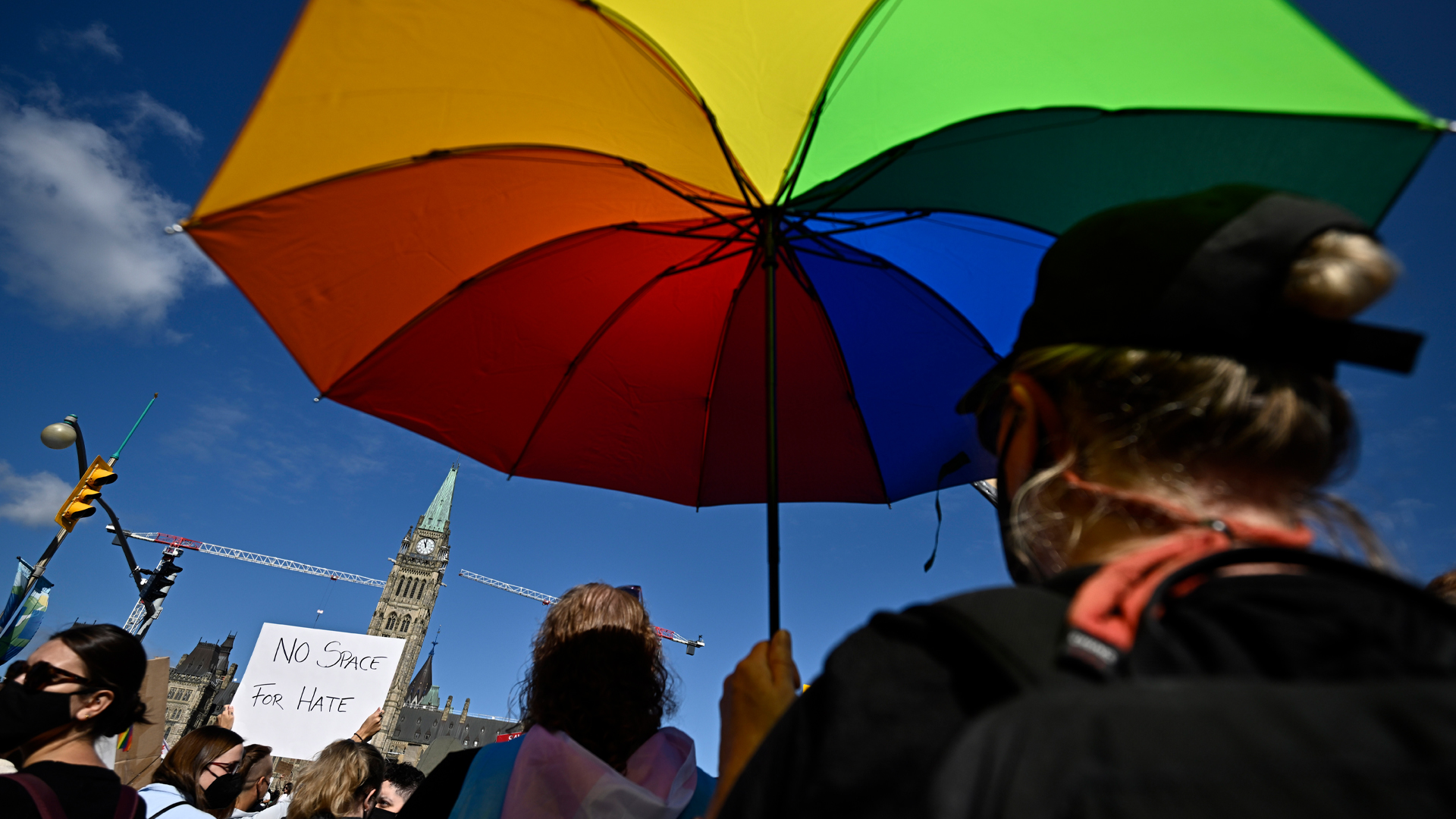
Section 33 of the Canadian Charter of Rights and Freedoms, known as the “notwithstanding clause,” has just about acquired the status of a zombie law in recent decades, left largely untouched by legislatures (at least in the Rest of Canada). Saskatchewan Premier Brad Wall recently took on the role of Victor Frankenstein, bringing the dead back to life in promising to protect the funding of non-Catholic students at Catholic schools by using this controversial provision of the Charter. He was responding to a judgment by a Saskatchewan trial court that said the province’s funding of non-Catholic students at Catholic schools infringed Charter rights unjustifiably.
The controversy over the government’s response has exposed some basic tensions between the regime of abstract individual rights envisioned by Charter jurisprudence and the historical bargain, including enshrined rights for religious communities, that led to Confederation. More specifically, Justice Donald Layh’s decision in GSSD v. CTT constructs an interpretive latticework over the basic framework of the Charter rights to freedom and equality that undermines the structural integrity of their broader constitutional context. The controversy over Saskatchewan’s declared intention to use section 33 to protect its interpretation of the constitutional rights of denominational schools also reveals some confusion over the role of the notwithstanding clause, which should be understood not as the “nuclear option” but rather as an institutional rule shaping the relationship between courts and legislatures.
The historic constitutional guarantee in section 93 of the Constitution Act — which permits Catholics to petition their provincial governments in Ontario, Saskatchewan and Alberta to form a separate denominational school board if they form a minority in a given school board — jostles uncomfortably with how the courts have constructed, or interpreted, vague provisions of Charter rights, particularly those concerning the state’s obligation of religious neutrality. Obviously, it is not “neutral” that Christians, and no other faith groups, have the right to demand a separate school board financed by the public purse in order to protect their minority communities. If we were to design a constitution today, it’s unlikely that we would contemplate such a provision. Nonetheless, it is a part of the firmament of the Constitution for historically important reasons — a “solemn pact” that “made Confederation possible” — and any balancing of competing individual rights and state obligations must proceed with deference to this fact of Canada’s founding. Both parties in the litigation agreed that section 93(1) freezes and entrenches the constitutionally protected status of separate schools.
It is on this point that the trial judge’s reasoning eventually goes awry. The judge rightly distinguishes between constitutionally entrenched rights of denominational schools to educate religious students and nonconstitutionally entrenched rights of those schools to receive public funding for their non-Catholic students. This entails a fine-toothed parsing of “denominational” and “nondenominational” aspects of separate school boards’ rights, in order to determine whether a legislature’s decision to provide funding for non-Catholic students attending Catholic schools could be shielded by section 93(1) from Charter analysis. The judge concludes that such immunity does not exist, which seems to us to be a reasonable conclusion.
Less sound is the judge’s subsequent Charter analysis, for the purpose of determining whether state funding for non-Catholic students violates Charter equality rights, in section 15, and religious neutrality rights, in section 2(a). Understanding the historical context of denominational schools’ constitutional status is crucial in assessing whether the state has violated these rights. Saskatchewan’s Confederation compromise entailed a built-in elevation of the status of Catholics — on its face, a Charter violation, but one that it would be nonsensical to deem a violation in law since it is embedded in the Constitution Act itself. That being the case, the government can hardly be indifferent to the religious status of the students attending Catholic schools. Within these historical strictures, extending a benefit on equal terms to religious and nonreligious citizens alike does not violate a principle of religious neutrality — it is the definition of neutrality.
Besides, the Charter itself does not explicitly require state neutrality vis-à-vis religion, while it does explicitly mandate special treatment for Catholic and Protestant schools. Here we might draw a comparison with the American Constitution’s “establishment clause,” which does impose such a neutrality requirement. In Canada, state religious neutrality has been “read in,” or constructed by judges over time, always with the exception of section 93’s protection of denominational schools. It is striking that in the US, where the establishment clause explicitly prohibits the state sponsorship or endorsement of religion, the 2002 case of Zelman v. Simmons-Harris enabled religious schools to participate in a voucher program in which parents received subsidies from the state of Ohio to send their children to schools outside of failed school districts. In the US, where the state is prohibited from religious sponsorship, public vouchers to attend religious schools were upheld, while in Canada, despite our Constitution’s protections for Catholic schools, public funding of students whose parents choose to send them to these schools was found unconstitutional.
The Saskatchewan judge’s reasons turn on a highly technical bit of reasoning: public funding of Catholic schools amounts to an “axiomatic” Charter breach, but such funding is narrowly shielded from Charter scrutiny for constitutional reasons. The aspects of funding that fall outside of the shield — funding for non-Catholic students — are thus discriminatory. But it helps to step outside of this equation for a moment. The Charter functions to give individuals rights vis-à-vis the state. The effect of the judge’s decision is that children who, for whatever reason, wish to attend denominational schools (which will exist one way or another) are shut out of such schools. In addressing the alleged problem of religious discrimination, the decision mandates that the benefit of educational choice extends only to religious citizens. Irony abounds.
This construction of how Charter rights to religious freedom and equality relate to other constitutional provisions raises the question of the potential implications of the decision and how they would be reflected in practice. Making Catholic schools’ access to public funds dependent on established mechanisms to determine which of its students are classified as Catholic seems to invite and require intrusive practices and the establishment of some uniform test for who is a “true” Catholic. Does participation in sacraments suffice? Being baptized? Or would students have to undergo the Supreme Court’s preferred test for protected religious practice, which queries whether a person has a “sincere belief that has a nexus with religion”? The potential intrusiveness of such tests makes the government’s decision to simply fund all students who wish to attend denominational schools a reasonable interpretation of accommodation of Charter rights.
Premier Wall’s government has drawn both praise and derision for its decision to contest the court’s Charter constructions by using section 33. The notwithstanding clause allows the federal and provincial governments to pass legislation shielded from judicial review in relation to certain sections of the Charter. Saskatchewan plans to insulate its new legislation protecting the rights of non-Catholic students to attend Catholic schools for a renewable period of five years. The government is justified in using section 33 in this context: the notwithstanding clause was designed for defending precisely the kind of legislative constructions of Charter rights reflected in this situation. Criticism of the government’s proposal results partly from confusion over the indistinct relationship between the Charter and the Constitution, but partly also from controversy over the role of section 33 in enabling legislatures to address judicial errors.
Section 33 has recently been maligned as a betrayal of the Charter’s promise to protect the rights of individuals against the state, but when used properly it enhances the democratic quality of that promise. When considering the crucial role of judges in protecting the rights of Canadians, it is important to recall that they sit on one branch of the tree of the very constitutional state they are meant to prune. It would be naive to assume that judges are incapable of erring, or indeed that there might not be room for reasonable disagreement about their constitutional decisions. Section 33 was essential to renegotiating Canada’s constitutional compromise in 1982, especially from the vantage point of the former premiers of Alberta and Saskatchewan, Peter Lougheed and Allan Blakeney. They insisted on including section 33 as a means by which legislatures could either address clear judicial mistakes or signal their reasonable disagreements with the constitutional constructions of the judiciary. The government of Saskatchewan has ample grounds for justifying its prospective use of the notwithstanding clause on the latter basis, and the use of section 33 serves to complement the government’s appeal of the trial court’s decision.
We can infer that the Saskatchewan government views its plan for continuing the funding of nondenominational students at denominational schools as a valid way of determining how the Charter rights to religious freedom and equality fit alongside the Constitution Act’s section 93 protection of funding for minority denominations. The proposed legislation would invoke the notwithstanding clause not as an override of the Charter rights to religious freedom and equality but as a replacement of one particular judicial construction with a reasonable construction of how these rights relate to the rights in the Constitution Act. The government should be careful to orchestrate the text and oral justification of its Bill in a way that sets out its reasons for preferring an alternative Charter construction to that offered in GSSD v. CTT.
Articulate critics of the government’s decisions, such as Leonid Sirota, have pointed out that the government did not offer its constitutional reasoning in its press release on May 1, 2017. This critique assumes, wrongly, that legislatures are bound to offer judgelike reasons for their actions. A robust constitutional culture does not require that legislatures construct rights using the same technical language as jurists. Still, in an ideal world, Wall’s government would oblige its critics with its rationale for invoking section 33 and for any future legislation about denominational schools. In this way, it could signal the broader need for the Canadian judiciary to construct Charter rights in a way that aligns with the spirit of the Constitution Act, rather than treating even its explicit provisions as threats to amorphous Charter “values” and rights. If the government uses section 33 to legislate in a way that reconciles the Charter’s demands for religious freedom and equality with the Constitution’s protections for specific denominational groups, the government could help guide rather than contradict the outcome of any appeal of GSSD v. CTT. Critics who characterize section 33 as a “nuclear option” that permanently insulates a legislature’s actions from judicial review should recall that section 33 provides immunity for only five years unless it is renewed, after which the courts may assess the constitutionality of the statute. Since the likelihood of renewal is contingent on the reasonableness of a court’s potential assessment of the statute and the Saskatchewan government’s prospects of re-election, these variables should constrain the decisions of both the judiciary and the legislature.
Yet critics are correct to note that section 33 might be brandished inappropriately as a zealous politician’s weapon. In the Conservative Party leadership race, Kevin O’Leary and Lisa Raitt recklessly mused about using the clause to simply abolish rights that interfere with their policy objectives. Just as the power of judicial review can be exercised in more or less reasonable ways, so too can the power to pass legislation replacing judicial constructions of rights be abused. Section 33 is often associated with Quebec nationalists’ wielding of it as a formal protest against perceived incursions on Quebec’s sovereignty. In contrast, Saskatchewan’s use of the notwithstanding clause to respond to a judicial decision it disagrees with, based on a reasonable legislative construction of rights, could help rehabilitate the democratic reputation of the Charter and breathe new life into section 33. In doing so, it might bring our Charter-oriented rights culture closer in line with the democratic vision that inspired the prairie premiers to endorse the Charter in the first place.
Photo: A row of the flags of the provinces, territories and the federal government on stands forming a backdrop.(THE CANADIAN PRESS/Bayne Stanley)
Do you have something to say about the article you just read? Be part of the Policy Options discussion, and send in your own submission. Here is a link on how to do it. | Souhaitez-vous réagir à cet article ? Joignez-vous aux débats d’Options politiques et soumettez-nous votre texte en suivant ces directives.








